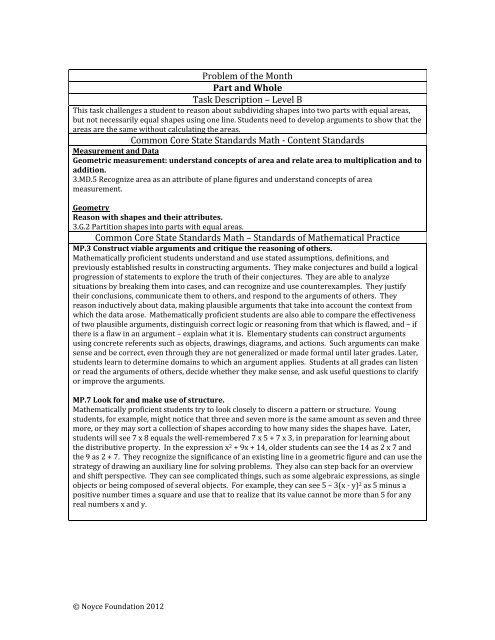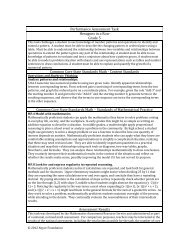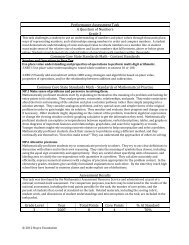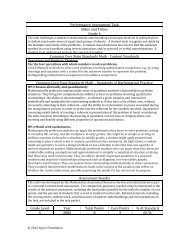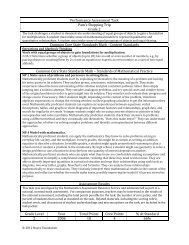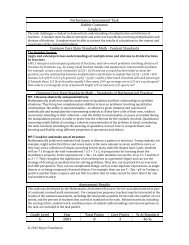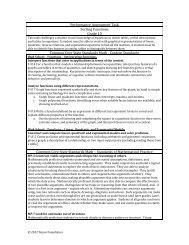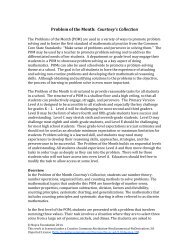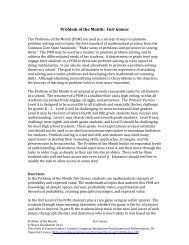subdividing
Problem of the Month Part and Whole - Inside Mathematics
Problem of the Month Part and Whole - Inside Mathematics
- No tags were found...
You also want an ePaper? Increase the reach of your titles
YUMPU automatically turns print PDFs into web optimized ePapers that Google loves.
Problem of the Month<br />
Part and Whole<br />
Task Description – Level B<br />
This task challenges a student to reason about <strong>subdividing</strong> shapes into two parts with equal areas,<br />
but not necessarily equal shapes using one line. Students need to develop arguments to show that the<br />
areas are the same without calculating the areas.<br />
Common Core State Standards Math - Content Standards<br />
Measurement and Data<br />
Geometric measurement: understand concepts of area and relate area to multiplication and to<br />
addition.<br />
3.MD.5 Recognize area as an attribute of plane figures and understand concepts of area<br />
measurement.<br />
Geometry<br />
Reason with shapes and their attributes.<br />
3.G.2 Partition shapes into parts with equal areas.<br />
Common Core State Standards Math – Standards of Mathematical Practice<br />
MP.3 Construct viable arguments and critique the reasoning of others.<br />
Mathematically proficient students understand and use stated assumptions, definitions, and<br />
previously established results in constructing arguments. They make conjectures and build a logical<br />
progression of statements to explore the truth of their conjectures. They are able to analyze<br />
situations by breaking them into cases, and can recognize and use counterexamples. They justify<br />
their conclusions, communicate them to others, and respond to the arguments of others. They<br />
reason inductively about data, making plausible arguments that take into account the context from<br />
which the data arose. Mathematically proficient students are also able to compare the effectiveness<br />
of two plausible arguments, distinguish correct logic or reasoning from that which is flawed, and – if<br />
there is a flaw in an argument – explain what it is. Elementary students can construct arguments<br />
using concrete referents such as objects, drawings, diagrams, and actions. Such arguments can make<br />
sense and be correct, even through they are not generalized or made formal until later grades. Later,<br />
students learn to determine domains to which an argument applies. Students at all grades can listen<br />
or read the arguments of others, decide whether they make sense, and ask useful questions to clarify<br />
or improve the arguments.<br />
MP.7 Look for and make use of structure.<br />
Mathematically proficient students try to look closely to discern a pattern or structure. Young<br />
students, for example, might notice that three and seven more is the same amount as seven and three<br />
more, or they may sort a collection of shapes according to how many sides the shapes have. Later,<br />
students will see 7 x 8 equals the well-remembered 7 x 5 + 7 x 3, in preparation for learning about<br />
the distributive property. In the expression x 2 + 9x + 14, older students can see the 14 as 2 x 7 and<br />
the 9 as 2 + 7. They recognize the significance of an existing line in a geometric figure and can use the<br />
strategy of drawing an auxiliary line for solving problems. They also can step back for an overview<br />
and shift perspective. They can see complicated things, such as some algebraic expressions, as single<br />
objects or being composed of several objects. For example, they can see 5 – 3(x - y) 2 as 5 minus a<br />
positive number times a square and use that to realize that its value cannot be more than 5 for any<br />
real numbers x and y.<br />
© Noyce Foundation 2012


